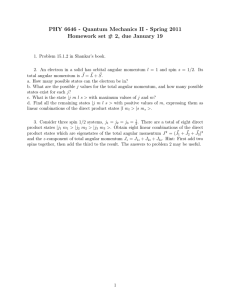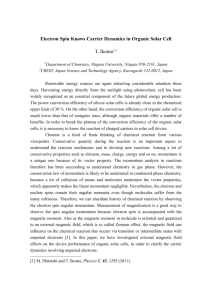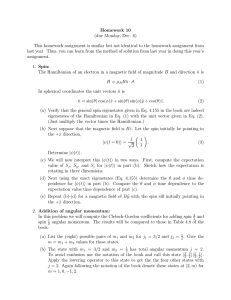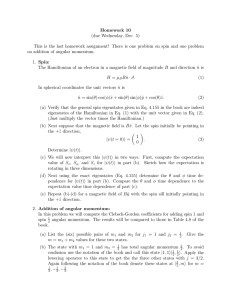Angular Momentum and Spin
advertisement
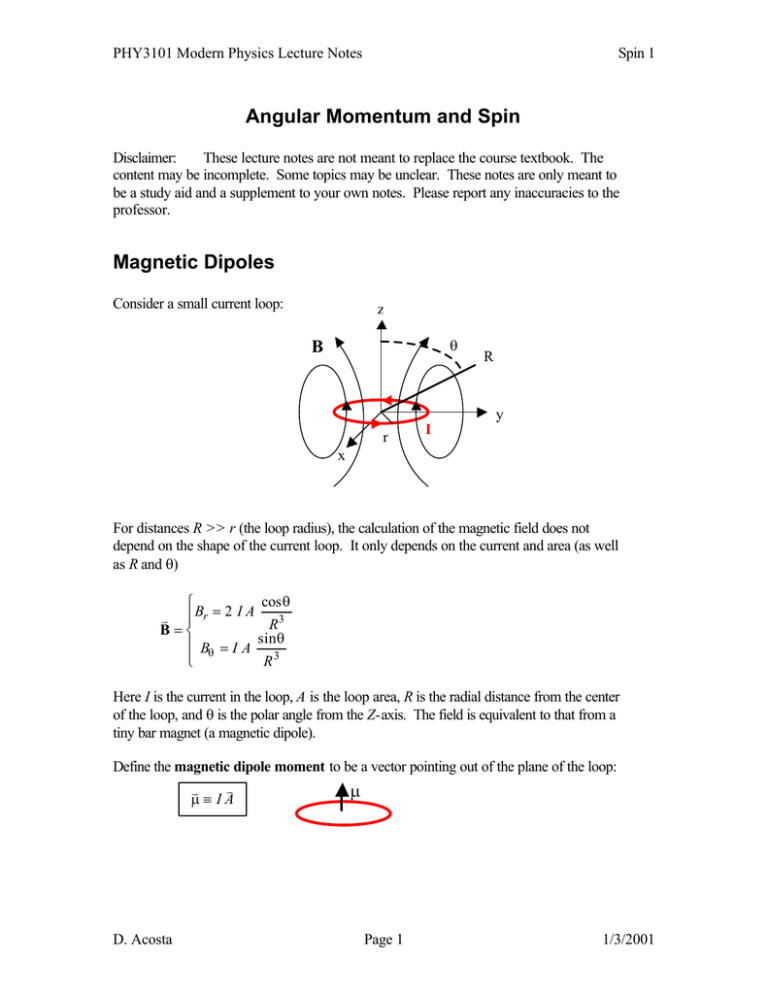
PHY3101 Modern Physics Lecture Notes Spin 1 Angular Momentum and Spin Disclaimer: These lecture notes are not meant to replace the course textbook. The content may be incomplete. Some topics may be unclear. These notes are only meant to be a study aid and a supplement to your own notes. Please report any inaccuracies to the professor. Magnetic Dipoles Consider a small current loop: z θ B R y r I x For distances R >> r (the loop radius), the calculation of the magnetic field does not depend on the shape of the current loop. It only depends on the current and area (as well as R and θ) R B = 2 I A cosθ v | R B=S sinθ |T B = I A R r 3 θ 3 Here I is the current in the loop, A is the loop area, R is the radial distance from the center of the loop, and θ is the polar angle from the Z-axis. The field is equivalent to that from a tiny bar magnet (a magnetic dipole). Define the magnetic dipole moment to be a vector pointing out of the plane of the loop: v v µ µ≡ IA D. Acosta Page 1 1/3/2001 PHY3101 Modern Physics Lecture Notes Spin 1 When placed in an external magnetic field, a magnetic dipole feels a torque: B v r v τ = µ×B µ This cause the dipole to precess around B. The potential energy of a magnetic dipole in an external magnetic field is: v v V = −µ ⋅ B v v The lowest energy configuration is for µ and B parallel. Work (energy) is required to realign the magnetic dipole in a B field. B µ B µ Lowest energy Highest energy Atomic Dipoles An electron “orbiting” an atom is like a small current loop. Let’s consider first a classical model of the atom, with the electron in a circular orbit: L µ r e- I We can determine the magnetic dipole moment as follows: µ = IA= a−ef π r 2 T 2π r = period v −e −erv ⇒µ = vπ r 2 = 2π r 2 T= a f But angular is defined as: v momentum v v L=r×p v L =| L| = rp = mvr for circular orbits This implies: v −e v µ= L 2m D. Acosta Page 2 1/3/2001 PHY3101 Modern Physics Lecture Notes Spin 1 The amazing thing is that this relation, which was defined classically, also holds in quantum mechanics when we replace the angular momentum vector with the angular momentum operator. The details of the orbit are not important, only that there is some net angular momentum. An atom with an electron in an orbit with angular momentum is a small current loop, which implies that it is also a magnetic dipole. Now consider an atom immersed in an external magnetic field applied along the z-axis. The potential energy is: v v V = − µ ⋅ B = − µ z Bz and the magnetic dipole moment is: −e µz = L 2m z −e ⇒ µz = L where Lz = mlh for the H atom 2m z Thus, we have: V = − µ B B ml µB = eh = 5.79 × 10 −5 eV / T = Bohr magneton 2me This potential energy must be added to the Coulomb potential energy of the hydrogen atom when solving the Schrodinger Equation. But if the external field is held constant, and the H atom is in a definite orbit with fixed l and ml , then this term just adds or subtracts from the energy levels of the H atom. In other words, the energy degeneracy with respect to magnetic quantum number ml of the H atom is broken with the application of an external magnetic field. It is possible to see the effect of the quantization of angular momentum, because the energy levels will be split into 2l + 1 different levels, and the line spectra, therefore, will be split also. This is known as the normal Zeeman effect. It gives fine structure to spectral lines. The energy splitting between two levels is given by: E eh ∆E = µ B B∆ml = B with ∆m l = 1 2m For a 1 Tesla field, this splitting is 5.79 × 10 −5 eV, which is very small. D. Acosta Page 3 ∆E n=2 ml = −1 ml = 0 ml = 1 n=1 ml = 0 1/3/2001 l =1 PHY3101 Modern Physics Lecture Notes Spin 1 Spin and the Stern-Gerlach Experiment The normal Zeeman effect is not always seen. It turns out that orbital angular momentum is not the complete story, and that there exists intrinsic angular momentum. Let’s consider the Stern-Gerlach experiment of 1922. In that experiment, a neutral atomic beam is passed through an inhomogeneous magnetic field. (We use neutral atoms because otherwise there will be a Lorentz force on each atom: F = −q v × B). For such a field, there will be a force induced on the magnetic dipole moment of each atom: Fz = µ z ∂B ∂z Z where the field gradient is chosen to lie along the z-axis. S ml = −1 ml = 0 ml = 1 beam N We thus expect to see the beam deflect depending on the value of µ z . Recall that: µz = −e Lz = − µ B ml 2m For the silver atoms used in the experiment, one would expect to see either no deflection, or three lines, or five, etc. depending on the value of l for the orbital angular momentum of each atom. (Actually, silver has its outermost electron in an s state, so one would expect no deflection since l=0 for the atom). One would definitely not expect to see only two lines, both of which are deflected from the straight-through direction. This is what was indeed seen, and something new must be going on. In 1925, Goudsmit and Uhlenbeck propose that the electron itself must possess intrinsic angular momentum. That is, the electron is like a small bar magnet! However, as far as we know from various measurements, the electron has no size. It is just a point. So we cannot think of it as a current loop arising from one charged object orbiting another. This intrinsic angular momentum is called spin, and it is purely a quantum mechanical effect. The spin of the electron is apparently only ½, because only two state are observed: 1 N = 2s +1 = 2 +1 = 2 2 So we introduce two more quantum numbers for the hydrogen atom: s and ms (like 1 1 1 l and ml ), where s = and m s = − , 2 2 2 D. Acosta Page 4 1/3/2001 PHY3101 Modern Physics Lecture Notes Spin 1 The intrinsic angular momentum operators are just like those for orbital angular momentum: a f 3 S$ 2ψ = s s + 1 h 2ψ = h 2ψ 4 h S$zψ = ms hψ = ± ψ 2 However, the magnetic dipole moment of the electron is: −eh m s = −2 µ Bm s = − gµ B ms m The factor g, the gyromagnetic ratio, is 2 for the electron whereas it was 1 for orbital angular momentum. It is predicted by the relativistic wave equation for the electron: the Dirac equation. In that equation, spin is a natural consequence for electrons, and one can consider the ms quantum number arising from the time coordinate in the equations (just as ml arose from the ϕ dependence, l from the θ dependence, and n from the r dependence of the non-relativistic Schrodinger Equation). Recall that in special relativity, time is on an equal footing with the spatial coordinates. µ ez = Returning to the Stern-Gerlach experiment, each silver atom has l = 0, so the entire magnetic moment of the atom comes from the outer electron, which has s = ½. Thus, there are two possible values for the electron’s magnetic dipole moment (neither of which are zero), and two beams are deflected through the inhomogeneous field. The experiment separates ms = ½, from ms = -½. Spin s = ½ is not the only possibility for particles. Although protons and neutrons also have spin ½, the photon has s = 1 (even though it is neutral and massless!), the pion has s = 0, and others have s = 3/2, 5/2, 7/2, … or s = 2, 3, … We will see that spin has certain implications for the superposition of wavefunctions, and that spin phenomena play a very important role in many areas of modern physics. D. Acosta Page 5 1/3/2001
